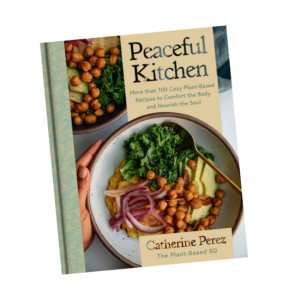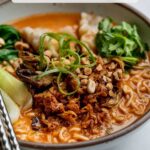Gochujang Peanut Noodle Soup
This gochujang peanut noodle soup uses a flavorful and effortless broth that pairs perfect with your favorite slurping noodles and dumplings. The perfect quick weeknight meal.
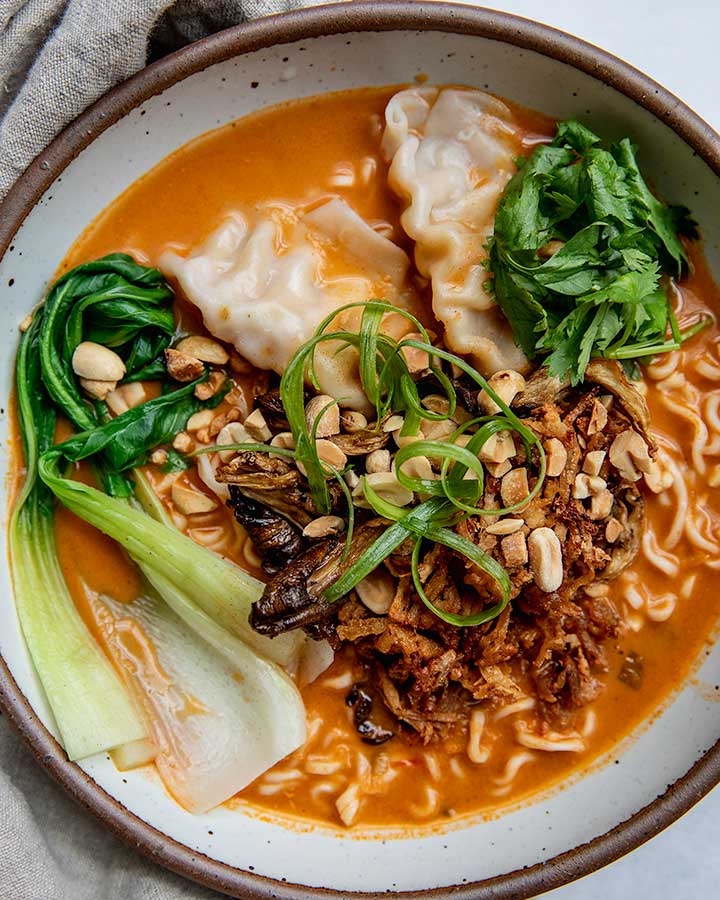
A cozy, spicy bowl of soup that is perfect for any cold or rainy day. The broth is nice and creamy, which lends a perfect base for any toppings you like. My ideal soup for any day of the week.
Why You’ll Love This Gochujang Peanut Noodle Soup
- The broth takes 15 minutes to make. Saute and caramelize the base ingredients, then stir in some vegetable broth until smooth and it’s ready to go!
- Make the broth ahead of time. Prep the broth in advance, then warm it up when ready to use.
- Easy to customize. Use my bowl as an example, but don’t limit yourself to customizing your bowl the way you like. The broth is the base, but topping choices are limitless!
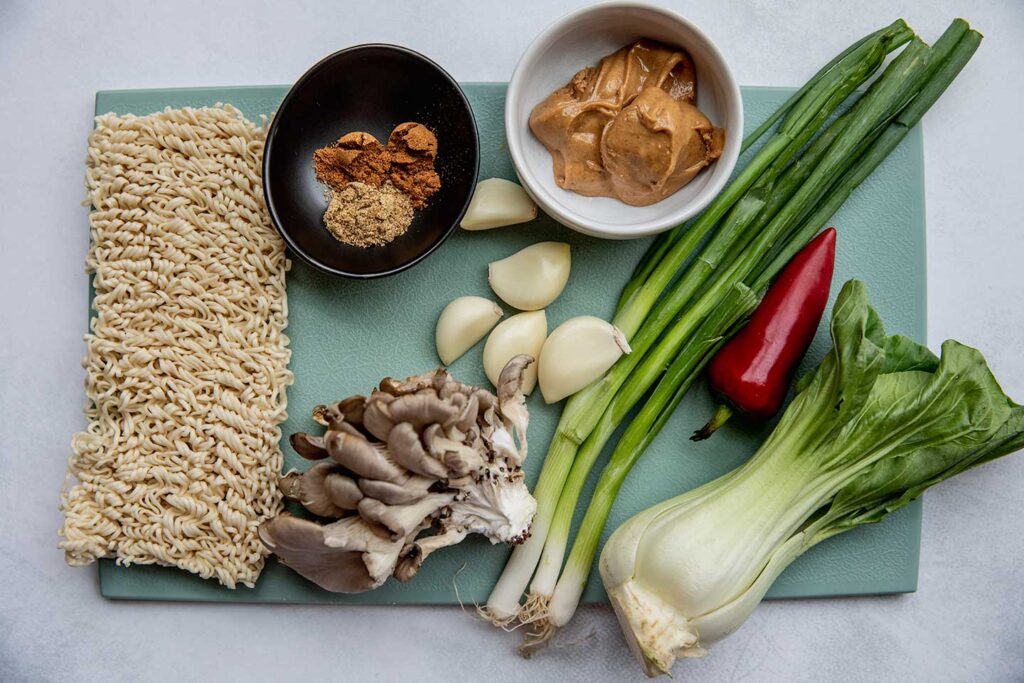
Key Ingredients and Substitutions
- Noodles: I used wheat noodles, but any cooked noodle can work here. For gluten-free option, try this with rice noodles.
- Oyster Mushrooms: I used these for topping, so they are completely optional. This variety of mushroom will give really great texture. This can also still work with regular baby bella mushrooms as well.
- Gochujang: This is a spicy Korean paste that has been gaining popularity and finding its way in a lot of grocery stores in the international section. If unable to find, feel free to swap with a tablespoon of yellow or white miso paste to make a miso based broth at the end of cooking. Please see notes in the Expert Tips section.
- Peanut Butter: Feel free to swap with almond butter, tahini, or sunflower seed butter if preferred.
- Scallions: If you want a stronger onion flavor, try using minced shallots instead.
- Aromatics: I used a combination of garlic and ginger. If you want a milder garlic flavor, use less garlic.
- Spices: I used a combination of coriander and Chinese Five Spice. Feel free to change up the spices or omit as desired.
- Milk: For a little natural sweetness I used an unsweetened oat milk, but this also works with soy milk or canned coconut milk.
How to Make Gochujang Peanut Noodle Soup
Cook the noodles and dumplings according to package instructions. Note that most noodles and dumplings may take anywhere from 3-8 minutes too cook.
To a large pot over medium low heat, add the mushrooms and spread them out over the bottom of the pan. Allow the mushrooms to sear for 3 minutes, then flip and sear on the opposite side for 2-3 minutes, pressing down on the mushrooms occasionally until most of the water evaporates. Drizzle with 2 teaspoons of oil and a pinch of salt and sauté the mushrooms for an additional 1-2 minutes until golden brown. Remove the mushrooms from the pan and add more oil to the pan as needed to warm through.
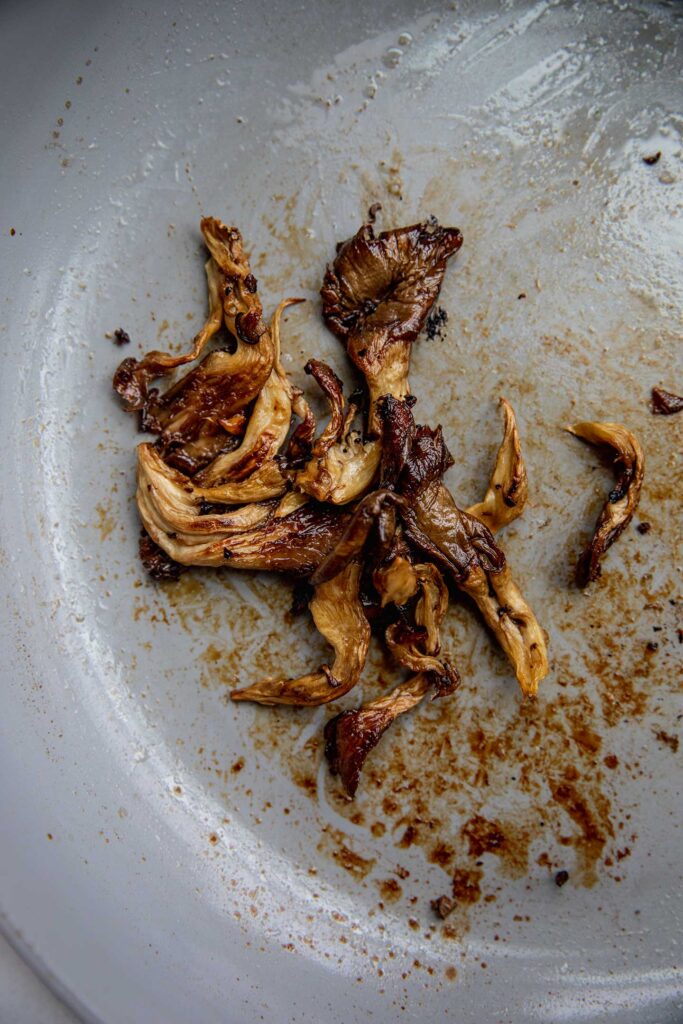

Once the oil is hot, add the white portion of the spring onions along with the pepper and a pinch of salt then sauté for about 2 minutes or until softened. Add the garlic and ginger, then stir and cook until fragrant.
Add the gochujang, coriander, Five Spice, and sugar and stir the mixture frequently in the pan for about 2 minutes to help deepen the color of the gochujang.
Stir in the peanut butter then pour in the vegetable broth. Whisk everything together until you get a uniform broth with no clumps.

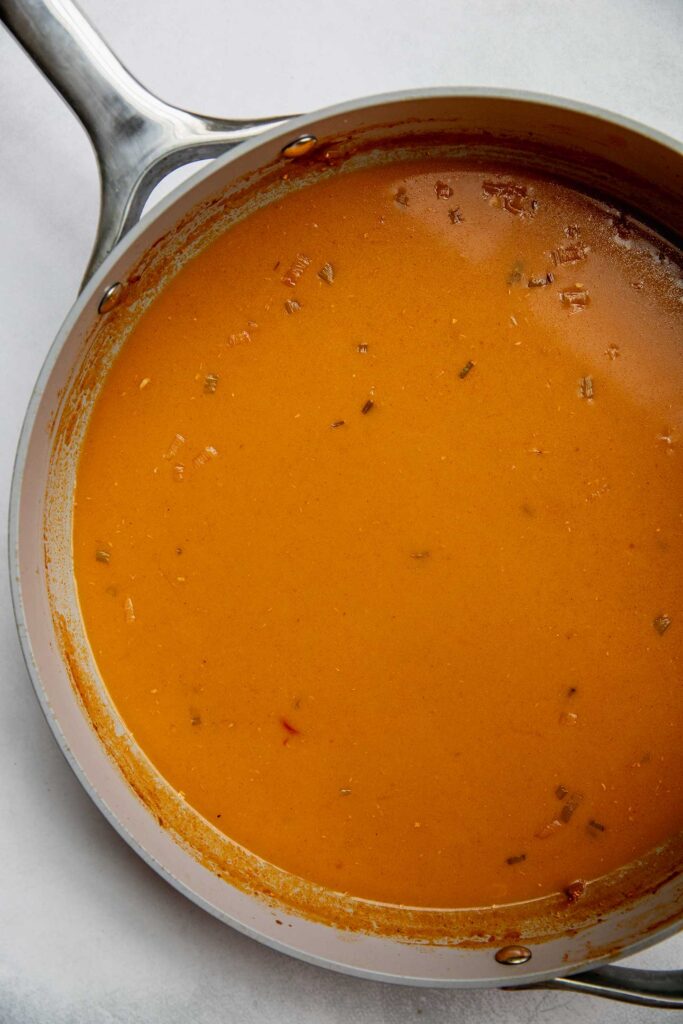
Bring the broth to a simmer, then lower the heat to the lowest setting. Pour in the tamari and milk, stir well to combine then leave on the heat for 1-2 minutes to warm through.
To serve, portion out your noodles and dumplings as desired then ladle some broth to cover. Top with extra toppings like steamed veggies, your favorite plant-based protein (I used shredded tofu), cilantro, scallions and crushed peanuts.
Expert Tips
- Use fewer pots and pans. There are a number of ways to do this.
- If sauteing vegetables or dumplings, do it in the same pan that you plan to make your broth in.
- If steaming veggies, steam them using the same pan you cook your noodles in.
- Don’t want to use a pot for the noodles? Use rice vermicelli noodles that can be cooked in a bowl with boiling water until softened.
- You can also use some microwave veggies and proteins too like corn and edamame. Do what works for you.
- Change up the toppings. Don’t feel like you need to use every topping I used here. Lots of different option ideas can be found within this blog post.
- Adjust the spice. Gochujang may be spicy for some. If that is the case, try this with less gochujang or swap with some miso paste. If using miso, add it to a bowl with a portion of broth and whisk until smooth. Add this mixture back to the pot at the end before serving to retain it’s probiotic benefits.

Frequently Asked Questions
Yes! Use rice noodles. These should be completely gluten-free as is and you can also choose whole grain options that can help boost the protein and fiber content of the meal. You will also want to make sure you are using a gluten-free tamari (or coconut aminos) and gluten-free gochujang paste. The remainder of the ingredients should be gluten-free naturally without need for substitution.
Yes, try this soup with seitan instead of tofu. You can also use pea-protein crumbles that you can season yourself as well. For veggies, sauteed mushrooms and charred corn are always a favorite topping.
Yes, just swap the peanut butter and peanuts for a different nut or seed of choice. This works with almond butter, sunflower seed butter and tahini as well.
I would recommend just making the broth in advance and heating it up when ready to use with some freshly cooked noodles. Store the broth in a airtight container in the fridge for up to 3-4 days.
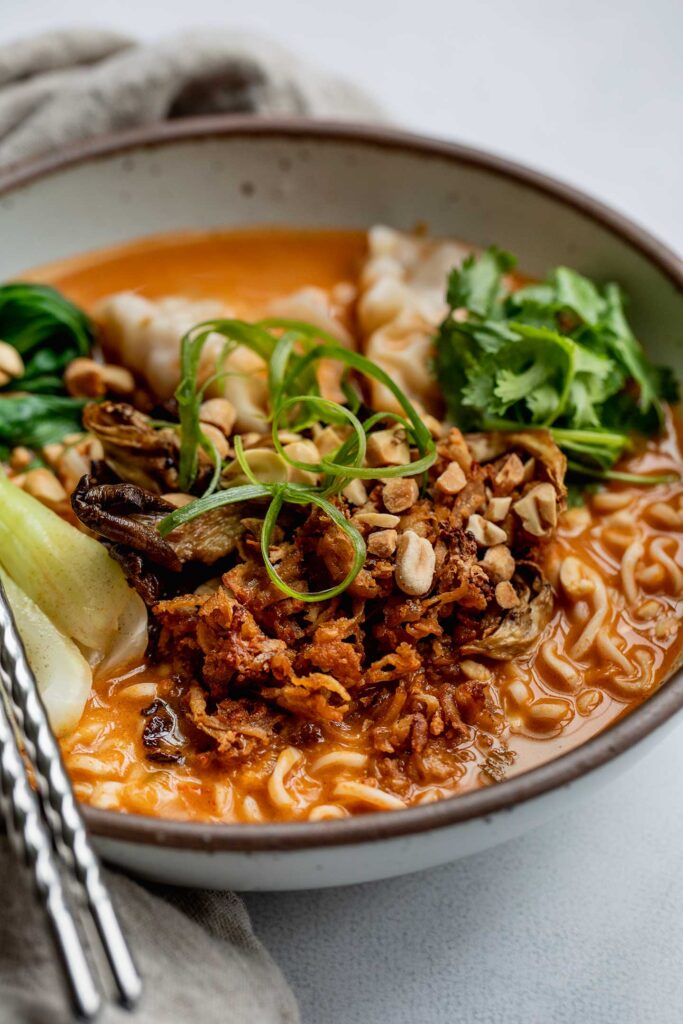
Soup Topping Options
- Sauteed Veggies: In the same pan that you create your soup base, start by sautéing the veggie toppings you want. I chose to sauté some mushrooms (I know it is a fungi), but you can also sauté some greens,
- Dumplings: I love playing around with different textures and ingredients, so using dumplings is something I love to add to brothy soups. I used a veggie filled dumpling, but any variety you love can work here.
- Tofu: If you want this soup to be a full meal with more protein try topping with shredded tofu or baked tofu.
- Edamame: Make a quick protein addition with some thawed frozen edamame.
- Steamed Veggies: What I often like to do to save myself from cleaning multiple pots is to steam the veggies using the same pot I am cooking my noodles in. You can try veggies like
- Herbs: I love topping this soup with extra fresh scallions and cilantro for a bite of freshness. This soup can also work with fresh chives or Thai Basil.
- Crispy Tempeh: You can use the crispy tempeh found in this Potato Soup recipe to top over this noodle bowl.
More Cozy Plant Based Soups
- Roasted Butternut Squash Gnocchi Soup
- Creamy Vegan Pot Pie Soup
- Chipotle Red Lentil Potato Soup
- Vegan Asopao Dominicano
- Sweet Potato Red Lentil Soup
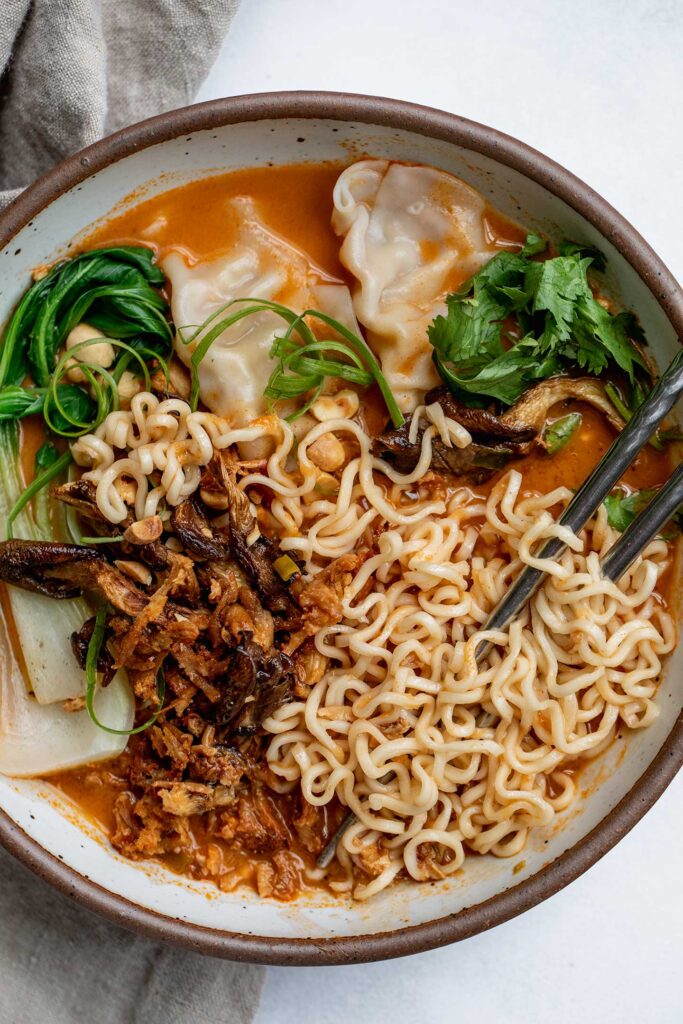

Gochujang Peanut Noodle Soup
- Prep Time: 15 minutes
- Cook Time: 20 minutes
- Total Time: 35 minutes
- Yield: 3 servings 1x
- Category: Soup
- Method: Stove Top
- Cuisine: American
- Diet: Vegan
Description
This gochujang peanut noodle soup uses a flavorful and effortless broth that pairs perfect with your favorite slurping noodles and dumplings. The perfect quick weeknight meal.
Ingredients
- 5 oz oyster mushrooms, torn into small flat pieces
- 1–2 tbsp avocado oil or favorite neutral oil
- 4 spring onions, thinly sliced with white and green portions separated
- 1 chili pepper, thinly sliced (optional)
- 5 cloves garlic, grated or crushed with a garlic press
- 1/2 inch ginger, grated
- 1–2 tbsp gochujang
- 1/2 tsp ground coriander
- 1/2 tsp Chinese Five Spice, optional
- 1 tsp light brown sugar or coconut sugar
- 2 tbsp natural peanut butter
- 3 cups vegetable broth
- 1 tbsp tamari
- 1 cup unsweetened oat milk or coconut milk
- 3 servings of your favorite noodles
- Store Bought Veggie Dumplings
- Kosher salt as needed
Topping Options
- Steamed Bok Choy
- Shredded Smoked Tofu
- Cilantro
- Crushed Roasted Peanuts
Instructions
- Cook the noodles and dumplings according to package instructions. Note that most noodles and dumplings may take anywhere from 3-8 minutes too cook.
- To a large pot over medium low heat, add the mushrooms and spread them out over the bottom of the pan. Allow the mushrooms to sear for 3 minutes, then flip and sear on the opposite side for 2-3 minutes, pressing down on the mushrooms occasionally until most of the water evaporates. Drizzle with 2 teaspoons of oil and a pinch of salt and sauté the mushrooms for an additional 1-2 minutes until golden brown. Remove the mushrooms from the pan and add more oil to the pan as needed to warm through.
- Once the oil is hot, add the white portion of the spring onions along with the pepper and a pinch of salt then sauté for about 2 minutes or until softened. Add the garlic and ginger, then stir and cook until fragrant.
- Add the gochujang, coriander, Five Spice, and sugar and stir the mixture frequently in the pan for about 2 minutes to help deepen the color of the gochujang.
- Stir in the peanut butter then pour in the vegetable broth. Whisk everything together until you get a uniform broth with no clumps.
- Bring the broth to a simmer, then lower the heat to the lowest setting. Pour in the tamari and milk, stir well to combine then leave on the heat for 1-2 minutes to warm through.
- To serve, portion out your noodles and dumplings as desired then ladle some broth to cover. Top with extra toppings like steamed veggies, your favorite plant-based protein (I used shredded tofu), cilantro, scallions and crushed peanuts.
Notes
Use fewer pots and pans. There are a number of ways to do this. If sauteing vegetables or dumplings, do it in the same pan that you plan to make your broth in. If steaming veggies, steam them using the same pan you cook your noodles in. Don’t want to use a pot for the noodles? Use rice vermicelli noodles that can be cooked in a bowl with boiling water until softened. You can also use some microwave veggies and proteins too like corn and edamame. Do what works for you.
Change up the toppings. Don’t feel like you need to use every topping I used here. Lots of different option ideas can be found within this blog post.
Adjust the spice. Gochujang may be spicy for some. If that is the case, try this with less gochujang or swap with some miso paste. If using miso, add it to a bowl with a portion of broth and whisk until smooth. Add this mixture back to the pot at the end before serving to retain it’s probiotic benefits.
If you tried this recipe or any other recipe on the blog, then let me know what you thought in the comments below! And if you loved it, don’t forget to rate it too. Feel free to follow on Instagram, Pinterest, and TikTok for the latest nutrition tips and recipe videos.
★ Catherine
This post contains affiliate links which means I will make a small commission if you purchase from those links. I only recommend and share products that I know, trust and personally use myself!
